By Ashley Friemel
The ease of travel, low-cost flights, and access to different cultures and customs around the globe has led to an explosion in travel — including irresponsible tourism “experiences” that promote wild animal cruelty.
Sadly, the innocent lives of hundreds of thousands of animals are the ones suffering from this growth in travel — in getting that Instagram shot riding an elephant, in that seemingly innocent tiger selfie.
According to World Animal Protection, it is estimated that over 550,000 wild animals are suffering to entertain tourists.
Are you unknowingly supporting this?
Irresponsible Tourism & The Exploitation Of Animals
I truly believe that most of us would never knowingly support wild animal cruelty and abuse. In fact, it’s often the case that many people hold, ride, and swim with animals because they love them, not realizing what they are actually supporting.
Unfortunately for the average tourist, companies that have exploited animal suffering are very good at their job.
They make you believe they love and take care of these animals, that these animals live comfortable lives.
If only that were true.
The point of this article is to help educate travelers on what is going on behind the scenes in the most prevalent animal exploitation practices in the tourism industry.
These are just a few examples of activities to watch out for and not participate in.
Hopefully reading this not only opens your eyes to the cruelty behind these specific activities but also equips you to better support ethical animal tourism.
To start looking at the condition of the horse before you purchase a carriage ride.
Is the horse skin and bones? Is it forced to work in 100-degree temperatures? Is it pulling a weight that seems overly demanding?
To be responsible travelers it is our job to think past that perfect Instagram shot and really consider what is going on behind the scenes; to do our research and support responsible tour operators and experiences.
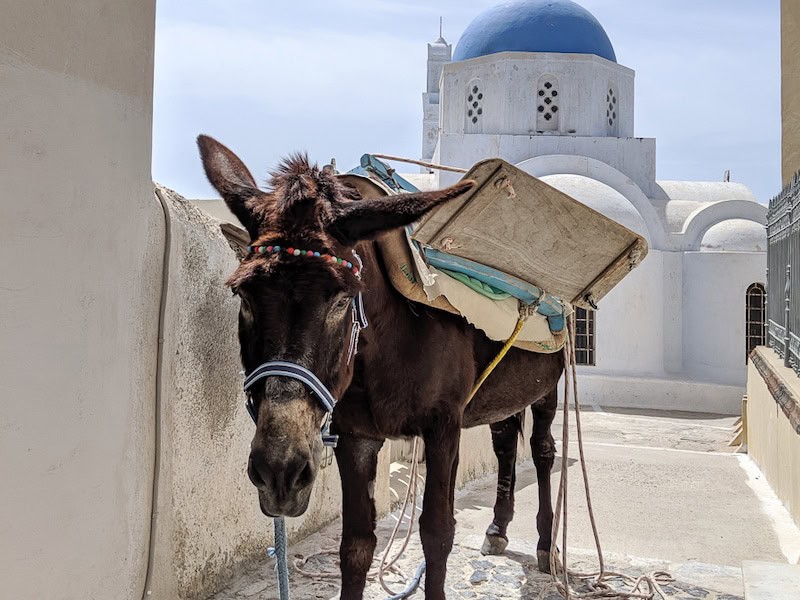
1. Riding Donkeys
Greece
Greece is exploding on social media.
Hordes of tourists flock to Santorini and other popular islands for the jaw-dropping views and picture-perfect sunsets.
A popular activity is to ride a donkey up and down the steep hills.
Amoudi Bay is located below the city of Fira in Santorini.
Here, groups of donkeys are strung together in a line and carry tourists from the bay up to Fira. It’s a challenging climb with over 600 steep steps — I did it several times and was out of breath and sweating by the time I reached the top — and that was with no added weight to carry.
These donkeys make this trek again and again.
According to The Observer and The Guardian, they work long hours, are often denied water, rest, and shade, and are regularly beaten. Many develop spinal injuries from carrying loads that are too heavy over and over again. Open wounds from improper saddles are not uncommon.
Every time I walked to Amoudi Bay I would stop and pet every single donkey for just a moment. I have never seen eyes so depressed and sad as these.
As long as tourists keep paying the money to ride these donkeys up the hill, they will forever remain in this unending cycle of torture and cruelty.

2. Horse Carriage Rides
NYC, Charleston, New Orleans
What’s more romantic than taking a carriage ride through Central Park in NYC?
Or maybe you arrive in Charleston and your kids see the horses pulling 10-to-20 people and they scream in excitement to hop on the next one.
While seeing a city by being pulled by a horse may not seem like a big deal, it is our duty as responsible travelers to think beyond the moment and what is happening behind the scenes.
Personally, I go to NYC several times a year and take a look at the lines of horses in Central Park with pushy owners trying to talk the next tourist into taking an overpriced ride.
Many of these horses are skin and bones, with their visible rib cages providing clues into improper care by their owners.
Have you unknowingly participated in an unethical #WildlifeTourism experience without realizing what you were supporting? #SustainableTourismYes, horses are strong and were used in times before cars and tractors to pull things. They were not meant to pull heavy loads of tourists on the blazing hot pavement surrounded by honking cars for long hours without breaks or adequate care.
Some of you may have even seen the videos that came out of horses collapsing on the streets of Charleston from dehydration and heatstroke.
According to World Animal Foundation and Animal Welfare Institute, these horses are worked far beyond their capacity.
They develop respiratory problems from breathing in car fumes along with leg injuries from walking on pavement day after day. Countless horses have died from being overworked — collapsing on the streets, being hit by reckless drivers, or being spoked and bolting.
Get some exercise and save your money by touring on foot.
And if you live in a city that offers horse-drawn carriages contact your local legislators to work towards banning this practice.
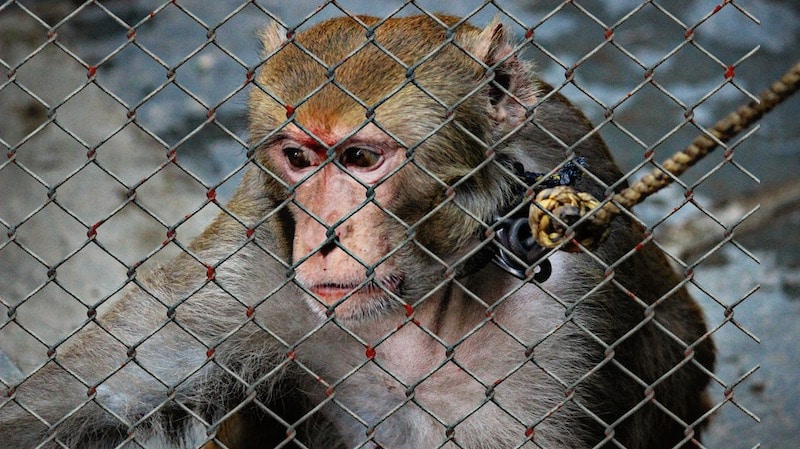
3. Photos With Wild Animals, Monkey Handlers & Snake Charmers
Morocco, South America, SE Asia — pretty much worldwide
If you’re in a tourist destination and see locals parading wild animals around trying to get tourists to take pictures with them, that should be your first red flag.
This was especially present in Morocco when Jake, my husband, and I visited Marrakech two years ago.
Morocco World News brings to attention that monkey handlers steal monkeys from the mountains.
When the monkeys aren’t on chains or spending the day being pushed upon tourists, they are typically locked in a small cage in complete isolation.
Moreover, Peregrine Adventures discusses how modern-day snake charmers aren’t what you think they are. The snake charmers sew the mouths shut to make it appear that they have control of the snake.
The snakes typically die within several days.
Wild animals are just that. Wild.
Don’t let your vacation entertainment support stealing animals from their habitats and families.
Add the above wildlife “attractions” to your list of things not to do in Morocco — and elsewhere.

4. Rodeos, Bull Fights & “Cultural” Shows
Spain, Canada, Southern America
Many Americans pride themselves on protecting animal rights. Unfortunately, there are still many instances where animal cruelty is being practiced for entertainment and profit.
An example:
Jake’s company had tickets to the rodeo in Fort Worth, Texas.
I’m not from Texas and have never been to a rodeo before, and I had no idea what to expect.
As I sat silently amongst families and young children cheering on cowboys riding bucking horses, I vowed I would never return to one again.
The Humane Society Veterinary Medical Association brings to light the cruel nature of rodeos. One “draw” to a rodeo is seeing the bucking horses; however, the way this happens is a flank strap is pulled tight around the belly just above the back legs. Sometimes spurs are added.
These horses often develop spinal injuries because they are not meant to buck this violently again and again whether for the actual performance or for the practice sessions behind the scenes.
Let's work together to help #animals by avoiding these unethical #WildlifeTourism 'attractions'Another disturbing rodeo spectacle is the calf roping event.
A baby calf — that would still be with its mother at this young age — sprints out of the holding cage to be lassoed around the neck, yanked back, slammed to the ground, and then have its feet tied together.
Not only is doing this to a baby calf once horrible enough in itself, but this is done again and again behind the scenes to give competitors practice.
These animals suffer from severe neck and spinal injuries. Rib cages are often broken and ligaments are torn, among other internal injuries.
Often, these calves either die from their injuries or are taken to the slaughterhouse once their injuries prevent them from performing.
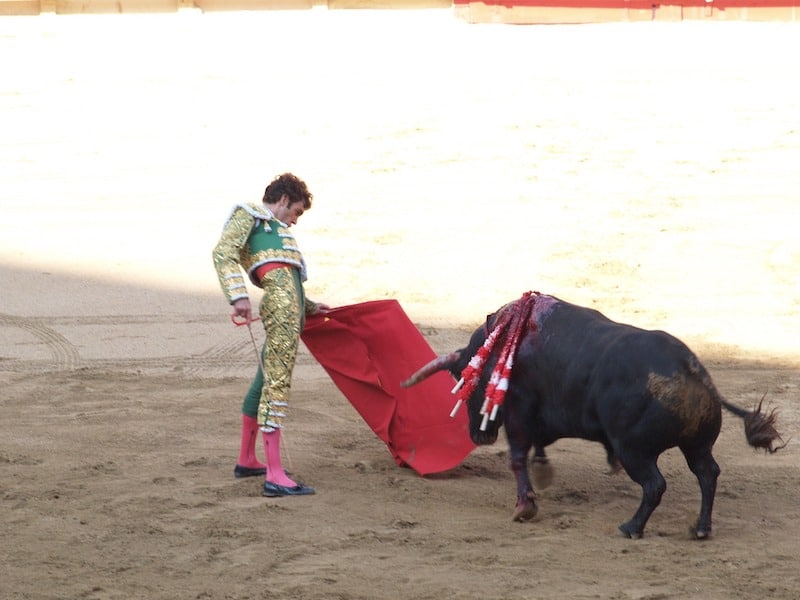
Think rodeos are bad?
Consider what goes on at bullfights in Spain where bulls are speared, drugged, and killed for sport. The League Against Cruel Sports details the cruel and gory tradition.
Remember this when booking an animal experience:
Just because something is “part of the culture” doesn’t mean it’s ethical. Just think about the gladiator games that were once part of Rome’s culture.
Consider what you are supporting when you attend events or performances.
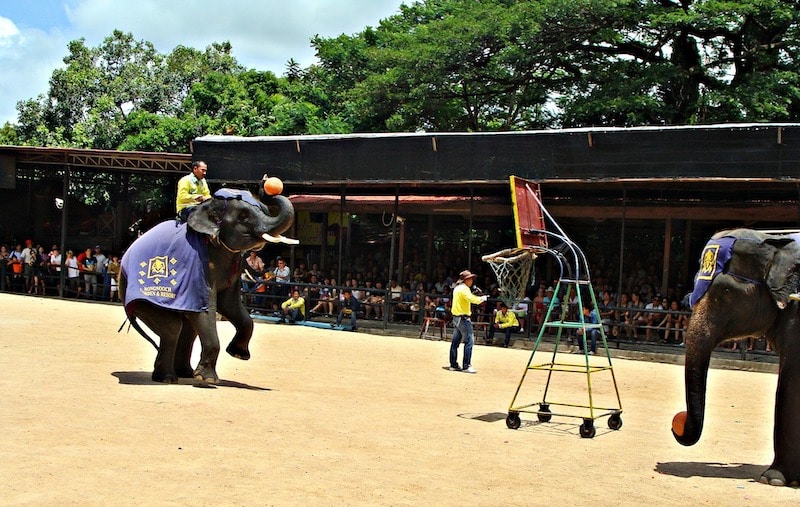
5. Elephant Camps
Southeast Asia, particularly Thailand
Elephants have become a major attraction in Southeast Asia — so much so that elephant camps are breeding elephants for the sole purpose of profiting from tourists.
Some camps train their elephants to do tricks like throwing darts or even painting.
But travelers must realize that the first step in training an elephant is to break their spirit.
According to The Guardian, this process is a brutal one filled with pain, isolation, and starvation.
Bullhooks are used during training as well as shows to force the elephant to follow demands.
Western tourists started straying from these unethical elephant treks and shows as it was pretty obvious these animals were performing tricks from fear-based training.
To keep animal lovers happy, companies started the trend of elephant bathing.
This may seem like an innocent practice; however, what most people don’t understand is that to make an elephant calm and tame enough to safely allow tourists to bath it, the elephant has to undergo the same brutal training a performing elephant has to undergo.

Take out the painful training that involves bullhooks and other painful devices and the picture still isn’t pretty:
When not entertaining tourists, the elephants are often locked up and chained to a post. It’s not uncommon for the chain to have spikes around the part that goes around the leg. National Geographic published a heartbreaking article describing the living conditions of these elephants.
Elephants live as long as humans, often up to 80 years. These elephants are taken from their mothers at an early age and face a lifetime of nothing short of slavery.
By the way:
Be wary of tourist attractions with the name “sanctuary” or “rescue center”. These terms are often used for the sole purpose of marketing and to make tourists feel like they are visiting a worthy attraction and that the company cares for its animals.
There are companies out there that do care for their animals and are true rescue centers. It’s our job to research and complete due diligence on what we are supporting.
One place to start when planning a responsible trip to Thailand is this guide sharing ethical things to do in Chiang Mai.

6. Tiger Selfies
Thailand
Tiger selfies have become quite popular on social media, but let’s take a look at what goes on behind the scenes.
National Geographic discusses how the cubs are usually taken from their mothers at birth and grow up in small cages, only to be taken out for money-making photo opportunities.
The mothers also breed at unsafe and painful rates in order to ensure there is a steady supply of cubs.
If a #WildlifeTourism experience seems unnatural, that's your first clue that it's unethical. #Wildlife should be viewed from afar and shouldn't be made to perform!As tigers are wild animals, it should be no surprise that the tigers are either drugged or chained to allow photos to be taken. The chains are extremely short to ensure the tiger cannot stand or really move.
If it seems unnatural for an animal to be doing something — such as a wild tiger posing for a photo with a tourist — then it probably is.

7. Performing Dolphins
Hawaii, Russia & China
Dolphins are extremely intelligent animals that some scientists say are second to humans in intelligence.
In the wild, dolphins swim long distances — around 60 miles a day — and are social creatures that live in pods.
Keeping these normally playful creatures in solitary confinement in small pools is cruel. The dolphins used in shows and “swim with dolphins” programs are often illegally captured or bred in captivity.
Travel Pulse published a report on dolphin cruelty explaining that dolphins in captivity have a shorter life expectancy than dolphins in the wild.
They often develop ulcers and self-inflicted wounds from stress.
Being confined to a small tank leads to depression, frustration, and aggressive behavior. Dolphins and whales become brutally attacked by their tank mates again and again as a result of their confined and shared space.
Sadly, Dolphin Quest — an attraction that advertises tourists getting to kiss, touch, and swim with dolphins — is ranked as the #1 attraction on TripAdvisor in Waikoloa, HI and #6 in Oahu, HI. There are so many incredible local experiences have in Oahu, and this shouldn’t be one of them.
Actually, Keiko Conservation has an entire article investigating Dolphin Quest and its cruel practices.
You can expect long responses from marketing employees when visitors give them a poor review describing how sad it was to see these dolphins in captivity. Take a look at the one-star reviews on TripAdvisor and then look at the well-crafted responses from the owners.
If you ever bring up questions about the humane treatment of a company’s animals or how the animals were obtained, owners and employees are often ready to give convincing answers to make you think these animals live an amazing life. If they didn’t, they would quickly be out of business.
Ultimately, it is up to you to research what is actually going on, and to really question the ethics of swimming with dolphins.

Let’s Stop Irresponsible Tourism
Hopefully, the above information helps educate travelers around the world about what is going on when it comes to animal welfare and tourism.
My intent with sharing the above information is not to make anyone feel bad about something they unknowingly participated in.
Instead, the goal is the help you think about what you’re supporting and what happens behind the scenes; to be smarter than just following along with what the world deems acceptable or entertaining.
The fact that you read this post shows that you care about animals and want to make sure your actions are not supporting animal suffering and cruelty.
Please educate your family and friends on what you read today by forwarding them the article or sharing it on social media.
What other animal welfare tips do you have for travelers?
Don’t forget to pin this important post for later!

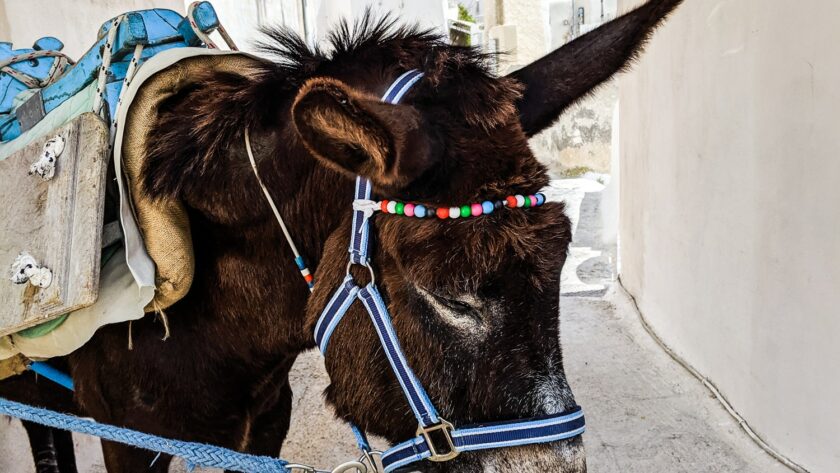





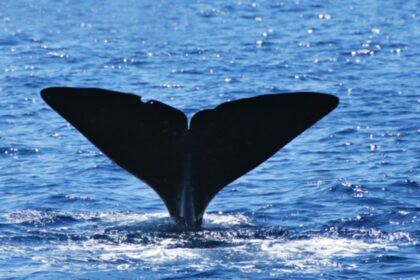

I finally found great post here.I will get back here. I just added your blog to my bookmark sites.
I’m so glad you enjoyed it! We all have a responsibility to be ethical travelers…and you reading this post shows your heart is in the right place 🙂
You make a very important point at the beginning – nobody is actively supporting animal cruelty, these people are just very, very good at their jobs. Your article does a really good job of explaining what goes on behind the scenes – particularly in Thailand!
Hopefully we can all be more aware the next time we see ‘attractions’ such as these.
I am so glad you took the time to read this and found it helpful. The first step in making a change is educating people. Many just don’t realize what is actually happening.
Hopefully, the above information helps educate travelers around the world about what is going on when it comes to animal welfare and tourism.
That is my hope as well. It’s so easy to blindly follow and do things without thinking of the repercussions.
hello boss, for those who want to win the Singapore lottery jackpot, just visit our fanspage my boss, guaranteed to win the Singapore lottery jackpot, don’t forget to follow it too, my boss, only at https://www.facebook.com/prediksgphariiniterbaru
This article provided good awareness and thank you for racing such concerns. We are also in the process of increasing recycled waste through tech. Here are some of the laptops that we research to provide e-waste solutions in the future.
Information that helps! Thank you so much for giving us this great article.